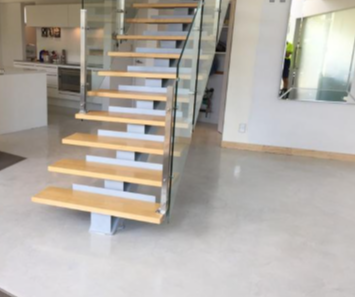The Complete Guide to Polished Concrete: Benefits, Applications, and Expert Tips
Polished concrete has become one of the most popular flooring solutions in both residential and commercial spaces. Its blend of modern aesthetics, durability, and ease of maintenance makes it a favorite for architects, interior designers, and homeowners alike. If you’re considering an upgrade to your flooring or simply want to learn more about this innovative surface, this guide will walk you through everything you need to know.
From understanding the process behind polished concrete to exploring its real-world applications and advantages, this article will help you make an informed decision—especially if you’re seeking polished concrete in Adelaide for your next project.
Polished concrete is a high-gloss finish created by mechanically grinding and honing a concrete surface, then treating it with a chemical hardener. The result is a sleek, smooth, and reflective floor that can rival the appearance of marble or granite but at a significantly lower cost.
Unlike surface coatings such as epoxy or vinyl, polished concrete is created by refining the existing concrete slab. This process enhances the natural texture and pattern of the material, offering a unique finish for every floor.
How Is Polished Concrete Made?
The process of creating polished concrete involves multiple steps and specialized equipment. Here’s a step-by-step breakdown:
1. Surface Preparation
The first step is to clean the surface thoroughly and remove any existing coatings, adhesives, or imperfections. This step is critical to ensure a smooth and durable finish.
2. Grinding
Using industrial-grade diamond grinders, the concrete is ground down to expose the desired level of aggregate (rocks and minerals within the concrete). The level of exposure can vary from minimal to full exposure, depending on the design preferences.
3. Hardening
After grinding, a chemical densifier is applied to the surface. This hardener penetrates the concrete and reacts with the calcium hydroxide, making the surface harder and more resistant to abrasions and dusting.
4. Polishing
Successive polishing stages follow, typically ranging from 400 to 3,000 grit levels, depending on the desired sheen. This can produce anything from a matte to a high-gloss finish.
5. Sealing (Optional)
While not always required, applying a stain guard or sealer can enhance the surface’s resistance to stains, water, and chemicals.
Benefits of Polished Concrete
Polished concrete offers numerous advantages over other flooring materials. Here are the top benefits:
1. Durability
Polished concrete is incredibly strong and can withstand heavy traffic, making it ideal for commercial and industrial environments. It resists chipping, scratching, and denting far better than softer materials like wood or vinyl.
2. Low Maintenance
Unlike other floor types, polished concrete requires minimal maintenance. Routine sweeping and occasional damp mopping are enough to keep it looking pristine. There’s no need for waxing or frequent resealing.
3. Cost-Effectiveness
Polished concrete is often more affordable than installing new tile, stone, or hardwood. Since the process involves working with the existing concrete slab, there’s no need for additional materials, which keeps costs down.
4. Eco-Friendly
This flooring option is considered green and sustainable. It reduces the need for additional materials, uses existing resources, and can help improve energy efficiency by enhancing ambient lighting with its reflective surface.
5. Aesthetic Appeal
Polished concrete offers a sleek, modern, and customizable look. You can choose from a variety of finishes, including matte, satin, or high gloss. Dyes and stains can also be added for color enhancement.
Popular Applications for Polished Concrete
Thanks to its versatility and durability, polished concrete can be used in a wide range of settings:
1. Residential Spaces
Polished concrete is making waves in home design. It’s ideal for open-plan kitchens, living rooms, and even bathrooms. Its reflective finish adds light and creates a sense of spaciousness. It also pairs beautifully with underfloor heating systems.
2. Retail Stores
Retail environments benefit from the low maintenance and sleek appearance of polished concrete. It provides a professional and inviting atmosphere while standing up to high foot traffic.
3. Warehouses and Factories
Durability is crucial in industrial environments, and polished concrete offers exactly that. It resists chemical spills, heavy equipment, and abrasions.
4. Office Buildings
Polished concrete adds a modern, upscale look to corporate environments. It also contributes to better indoor air quality by eliminating dust and allergens typically trapped in carpets or tile grout.
5. Hospitality and Restaurants
From cafes to luxury hotels, polished concrete provides a chic yet practical flooring solution that can easily match any interior style.
Design Options for Polished Concrete
Contrary to the misconception that concrete is dull or cold, polished concrete offers a variety of design possibilities:
1. Aggregate Exposure Levels
Choose between different levels of exposure:
- Cream Finish: No aggregate is exposed; gives a soft, clean look.
- Salt and Pepper: Small aggregate exposure for a speckled effect.
- Full Aggregate: Exposes large stones, creating a bold, decorative appearance.
2. Sheen Levels
From matte to high gloss, the finish can be tailored to your aesthetic and lighting requirements.
3. Color Enhancements
Integral coloring, dyes, or acid staining can be applied to achieve vibrant or subtle color tones that match your design palette.
4. Scoring and Stenciling
Patterns, logos, or borders can be added through scoring or stenciling, offering an artistic touch to commercial spaces.
Why Choose Polished Concrete in Adelaide?
Adelaide’s climate and architectural styles make it a great location for polished concrete installations. The flooring’s ability to reflect natural light is ideal for brightening homes and commercial spaces, especially in areas that receive plenty of sunshine.
Additionally, polished concrete is a perfect solution for energy-efficient buildings. Its thermal mass properties help stabilize indoor temperatures, reducing reliance on heating and cooling systems.
If you’re looking for trusted experts in polished concrete in Adelaide, Panorama Concrete provides specialized services with a reputation for excellence and attention to detail.
Common Misconceptions About Polished Concrete
1. It’s Slippery
Despite its glossy finish, polished concrete offers good slip resistance when dry. Anti-slip treatments can also be added if necessary.
2. It’s Cold
Concrete is not colder than other hard flooring types like tile or stone. Additionally, it can be paired with radiant heating systems to enhance comfort during cooler months.
3. It Cracks Easily
All concrete surfaces may develop minor cracks, but when properly installed and maintained, polished concrete resists significant cracking. Control joints and proper curing can help mitigate this risk.
4. It Looks Industrial Only
While it originated in industrial settings, modern techniques have made polished concrete highly adaptable to elegant and even luxurious design schemes.
Maintenance Tips for Polished Concrete
To keep your polished concrete looking its best, follow these care guidelines:
- Daily: Sweep with a microfiber mop to remove dust and debris.
- Weekly: Damp mop with a pH-neutral cleaner to maintain shine.
- Annually: Consider professional burnishing or reapplication of a protective sealer, if needed.
- Avoid: Harsh chemical cleaners or acidic substances, which can damage the finish.
How Much Does Polished Concrete Cost?
The cost of polished concrete can vary depending on several factors:
- Size of Area: Larger spaces may have lower per-square-meter rates.
- Existing Floor Condition: More prep work means higher costs.
- Finish Level: High-gloss and decorative finishes add to the price.
- Design Complexity: Custom colors, patterns, or aggregates can increase pricing.
Is Polished Concrete Right for You?
Polished concrete is a smart, stylish, and sustainable flooring choice for many environments. It’s especially suitable if you’re looking for:
- A modern, seamless look
- Long-term durability
- Easy maintenance
- Eco-conscious design
Whether you’re renovating a home, designing a new office, or outfitting a retail space, polished concrete offers a balance of function and form that’s hard to beat.
Read more: Transform Your Business Image with Professional Commercial Pressure Washing Services
Final Thoughts
Polished concrete is more than just a trend—it’s a long-term flooring solution that blends beauty, resilience, and affordability. Its rising popularity across Adelaide and beyond is a testament to its many advantages. From minimalist homes to bustling commercial centers, it continues to redefine how we think about concrete flooring.
If you’re ready to transform your space, explore the possibilities of polished concrete in Adelaide and connect with a professional team that understands both the craft and the local needs.






